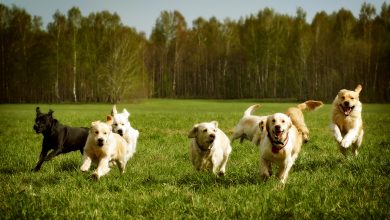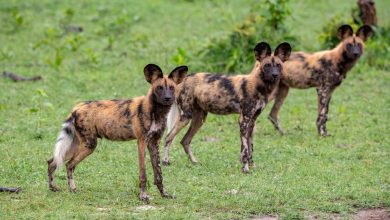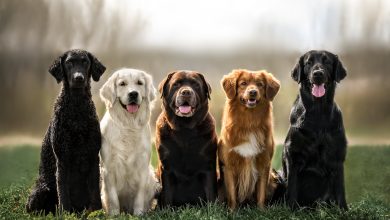The Ultimate Guide: 1,000 Must-Know Dog Facts

Welcome to The Ultimate Guide: 1,000 Must-Know Dog Facts! Whether you’re a new dog owner, a seasoned enthusiast, or simply someone who loves these loyal companions, this comprehensive guide is designed just for you. Our blog delves deep into the fascinating world of canines, consolidating a wealth of information into one accessible and engaging resource. From understanding your dog’s origins and breed traits to mastering their health, training, and grooming needs, we cover it all.
Knowing dog facts isn’t just about trivia; it’s essential for ensuring the well-being of your furry friend. Being informed helps you make better decisions regarding their nutrition, exercise, and overall care, ultimately leading to a happier and healthier pet. It also nurtures a stronger bond between you and your dog as you better understand their behaviors and needs.
In The Ultimate Guide: 1,000 Must-Know Dog Facts, you can expect to find a treasure trove of knowledge organized into five key sections: History and Breeds, Health and Wellness, Training and Behavior, Grooming and Care, and Fun Facts and Trivia. Each section is meticulously crafted to provide practical tips, intriguing insights, and valuable advice. So dive in and start exploring the incredible world of dogs!
1. History and Breeds
1.1 The Origin of Dogs
Dogs have a fascinating evolutionary background that traces back millions of years. They are believed to have descended from a now-extinct ancient wolf species, with genetic studies indicating a shared ancestry with modern wolves. Over time, through natural selection, early canids adapted to their environments and developed traits that suited their survival.
The domestication journey of dogs began approximately 15,000 to 30,000 years ago when humans and wolves formed a symbiotic relationship. Ancient humans benefited from wolves’ hunting skills and protective nature, while wolves gained from the food and shelter provided by human camps.
This mutually beneficial arrangement gradually led to the domestication of wild wolves into the various breeds of domesticated dogs that we know and love today. The evolution and domestication of dogs highlight an incredible transformation from wild predators to loyal companions.
1.2 Popular Dog Breeds
Popular dog breeds encompass a diverse array of shapes, sizes, and personalities, each bringing something unique to the table for potential pet owners. For example, the Labrador Retriever is renowned for its friendly and outgoing nature, making it an ideal family pet, while the German Shepherd is highly regarded for its intelligence and loyalty, excelling in roles such as service and police work.
Small breeds like the Poodle are celebrated for their hypoallergenic coats and agile intellect, perfect for apartment living and those with allergies. The Bulldog’s calm demeanor and distinctive wrinkled face make it a charming companion for those seeking a more laid-back pet.
Each breed has its unique set of traits and characteristics, ranging from high energy levels, trainability, and social tendencies, to specific grooming needs and potential health concerns. Understanding these traits is crucial in selecting the right breed that matches your lifestyle, ensuring a harmonious and fulfilling relationship with your canine companion.
1.3 Rare and Exotic Breeds
Exploring rare and exotic dog breeds opens up a fascinating world of unique canines that are lesser-known but equally endearing. Take the Xoloitzcuintli, or Mexican Hairless Dog, which boasts a history dating back over 3,000 years and holds a sacred status among the ancient Aztecs. Another intriguing breed is the Lagotto Romagnolo, an Italian truffle-hunter with exceptionally keen scenting abilities and a curly, dense coat.
The Norwegian Lundehund, once utilized for puffin hunting, is notable for its unusual anatomical features, including six toes on each foot and extraordinary flexibility. The Thai Ridgeback, often referred to as a national treasure in Thailand, is distinguished by the unique ridge of hair along its back that grows in the opposite direction to the rest of its coat. Each of these breeds carries rich histories and fascinating characteristics that make them remarkable discoveries for dog enthusiasts seeking something beyond the familiar.
2. Health and Wellness
2.1 Common Health Issues
Understanding common health issues in dogs is vital for every pet owner to ensure the well-being of their furry friend. Frequently encountered health problems include dental diseases, skin allergies, and arthritis. Dental diseases can lead to severe pain and tooth loss if left untreated, manifesting through bad breath, difficulty eating, and pawing at the mouth.
Skin allergies, often caused by environmental factors or food, can result in excessive scratching, redness, and persistent ear infections. Arthritis, especially prevalent in older dogs, leads to joint pain and stiffness, making it difficult for dogs to move around comfortably.
Recognizing signs and symptoms early—such as changes in appetite, lethargic behavior, unusual bumps, or changes in bathroom habits—is crucial for timely intervention and treatment. Regular vet check-ups, proper nutrition, and keeping an eye on any behavioral changes can help manage these health issues effectively, ensuring your dog enjoys a long and healthy life.
2.2 Nutrition and Diet
Ensuring your dog receives a balanced diet rich in essential nutrients is key to their overall health and longevity. Dogs require a mix of proteins, carbohydrates, fats, vitamins, and minerals to thrive. High-quality protein is crucial for muscle development and repair, while healthy fats provide energy and support a shiny coat. Carbohydrates supply necessary fiber, aiding in digestion.
Including a variety of vegetables and fruits can provide important vitamins and antioxidants, boosting your dog’s immune system. It’s also smart to avoid foods that are toxic to dogs, such as onions, grapes, and chocolate. Consulting with your vet can help tailor your dog’s diet to their specific needs, taking into account their age, weight, and activity level.
Consistency is key—establish a feeding routine and measure portions to prevent overfeeding, which can lead to obesity and associated health issues. Always ensure fresh water is available, and consider incorporating occasional treats to reward good behavior without compromising their nutritional balance.
2.3 Exercise and Physical Activity
Regular exercise is paramount to maintaining your dog’s overall health and well-being, much like it is for humans. Consistent physical activity helps to prevent obesity, improve cardiovascular health, and strengthen muscles and joints. Additionally, regular exercise can significantly enhance your dog’s mental health, reducing anxiety and preventing destructive behaviors born from boredom.
Fun activities to keep dogs fit include daily walks, which provide both physical exercise and mental stimulation from exploring new scents and sights. Playful games of fetch can also keep your dog active and engaged, while agility training offers a practical and enjoyable way to challenge their bodies and minds.
Swimming is another excellent option, particularly beneficial for older dogs or those with joint issues, as it provides a low-impact workout. Whether it’s hiking through nature trails, participating in dog sports, or simply having a play session in the backyard, ensuring your dog stays active is a wonderful way to promote a long, happy, and healthy life.
3. Training and Behavior
3.1 Basic Training Commands
Teaching your dog basic training commands is essential for fostering good behavior and ensuring their safety. Fundamental commands every dog should know include “sit,” “stay,” “come,” “heel,” and “down.” These commands provide a foundation for more advanced training and help in managing your dog in various situations.
Effective training involves consistency, patience, and positive reinforcement. Begin with short, focused training sessions to keep your dog engaged. Use treats or praise to reward your dog immediately after they successfully follow a command. It’s also crucial to practice commands in different environments to ensure your dog can obey them despite distractions.
Remember, every dog learns at their own pace; remain patient and avoid punitive measures, as they can lead to fear and anxiety. Creating a positive training experience strengthens your bond and helps your dog develop into a well-mannered companion.
3.2 Understanding Dog Behavior
Understanding dog behavior is crucial for fostering a harmonious relationship with your canine companion. Common dog behaviors such as barking, chewing, digging, and tail wagging can often be interpreted as forms of communication. For instance, barking may signify excitement, alertness, or fear, while chewing and digging are usually a dog’s way of exploring their environment or alleviating boredom.
Recognizing these behaviors allows you to address the underlying needs of your pet. Behavioral issues, such as aggression or separation anxiety, often stem from unfulfilled emotional or physical needs. Addressing these issues requires a balanced approach, incorporating both training and lifestyle changes.
Engaging your dog in regular physical activity, providing mental stimulation, and establishing a consistent routine can help mitigate undesirable behaviors. Positive reinforcement and patience are key when training your dog to adopt healthier habits. Consulting with a professional dog trainer or a veterinarian can also provide tailored strategies to help your dog overcome specific behavioral challenges effectively.
3.3 Socialization Skills
Socialization is a critical aspect of raising a well-adjusted and well-behaved dog. Proper socialization helps your dog feel comfortable and confident in various environments and situations, reducing the likelihood of fear-based behaviors such as aggression or anxiety.
Introducing your dog to a variety of people, animals, and experiences early on can help them develop important social skills. Some tips for socializing your dog include gradually exposing them to different settings, such as parks, busy streets, or pet-friendly stores, and allowing them to interact with other dogs and people under controlled circumstances.
Positive reinforcement, such as treats and praise, can encourage good behavior during these encounters. Puppy classes or playgroups can also provide structured socialization opportunities in a safe and supervised environment. By investing time in socializing your dog, you can ensure they grow into a friendly, well-behaved companion who can easily adapt to different social situations.
4. Grooming and Care
4.1 Grooming Basics
Grooming is an essential part of maintaining your dog’s health and appearance, and understanding the basics can make this routine both effective and enjoyable. Essential grooming tools include a quality brush suited to your dog’s coat type, nail clippers, a good canine shampoo, and ear cleaning solutions.
Regular brushing helps reduce shedding, prevents matting, and allows you to check for any skin issues or parasites. Nail trimming is equally important, as overgrown nails can cause discomfort and lead to mobility issues. Bathing your dog with a gentle shampoo keeps their coat clean and their skin healthy, while cleaning their ears helps prevent infections.
Additionally, breed-specific grooming needs must be considered. For instance, long-haired breeds like Shih Tzus require daily brushing and regular haircuts, whereas short-haired breeds like Beagles may need brushing once a week to manage shedding.
Dogs with floppy ears, such as Basset Hounds, are more prone to ear infections and may require more frequent ear cleaning. By tailoring your grooming routine to your dog’s specific needs, you can ensure they remain comfortable, clean, and healthy.
4.2 Dental Care
Maintaining your dog’s dental hygiene is vital for their overall health and well-being. Poor dental care can lead to periodontal disease, which, in turn, can cause pain, tooth loss, and more severe health issues such as heart, kidney, and liver disease.
Best practices for maintaining your dog’s dental health include regular brushing with a canine-specific toothpaste, providing dental chews or toys designed to reduce plaque, and scheduling annual veterinary dental check-ups.
It’s essential to start dental care early, gradually getting your dog accustomed to having their teeth brushed to ensure a stress-free routine. Incorporating these simple yet effective practices into your dog’s care regimen can prevent dental problems and contribute to a long, healthy life.
4.3 Safety and First Aid
Ensuring your dog’s safety and being prepared for emergencies is an essential aspect of responsible pet ownership. Basic first aid for dogs involves being able to quickly address common injuries and health issues. For instance, understanding how to clean and bandage a wound, control bleeding, or manage choking can significantly help your dog’s chances of recovery before professional veterinary care is available.
Additionally, having a well-stocked first aid kit designed for pets—with items such as antiseptic wipes, bandages, tweezers, and a digital thermometer—is key to being prepared for any situation. Preparing for emergencies also involves creating an emergency plan, which includes knowing the location of the nearest 24-hour animal hospital, having a list of important phone numbers, and keeping your dog’s medical records in an easily accessible location.
Training your dog to respond to basic commands like “stay” and “come” can also be crucial during emergency scenarios, ensuring their safety and securing their well-being. By equipping yourself with knowledge and tools, you can act swiftly and effectively to protect your furry friend in various situations.
5. Fun Facts and Trivia
5.1 Celebrity Dogs
Celebrity dogs have captured our hearts with their remarkable stories and achievements, both in history and media. One of the most famous dogs in history is Rin Tin Tin, a German Shepherd rescued during World War I, who went on to become a Hollywood star in the 1920s and 1930s. His incredible acting skills helped Warner Bros. rise to fame.
Another iconic dog is Lassie, a Rough Collie whose bravery and intelligence have been showcased in numerous films, television series, and books since the 1940s. More recently, celebrity dogs like Boo, the Pomeranian affectionately dubbed “the world’s cutest dog,” took social media by storm with his adorable photos and amassed millions of followers. These famous dogs have not only entertained us but also brought awareness to animal care and adoption, inspiring countless individuals to open their hearts and homes to pets in need.
5.2 Record-Breaking Canines
Dogs with extraordinary abilities and records never cease to amaze us with their feats of strength, intelligence, and agility. Take, for example, Zeus, a Great Dane recognized by the Guinness World Records as the tallest dog ever, standing a staggering 44 inches tall at the shoulder. Then there’s the speed demon Greyhound named Star Title, who holds the record for the fastest time over 500 meters, clocking in at an astounding 26.2 seconds.
Beyond physical prowess, dogs like Chaser, a Border Collie, have demonstrated immense intelligence by learning the names of over 1,000 toys. Fun and astonishing dog facts abound; for instance, did you know that a Bloodhound’s sense of smell is so accurate it can be used as evidence in a court of law?
Or that the Basenji dog is the only breed that doesn’t bark but instead makes a unique yodeling sound known as a “baroo”? These record-breaking canines and their remarkable capabilities not only highlight the incredible diversity within the dog species but also deepen our admiration and appreciation for our four-legged friends.
5.3 Unusual Dog Habits
Dogs have some unusual and amusing habits that often leave their owners puzzled and entertained. Behaviors such as the endearing “zoomies”—where dogs suddenly burst into a frenetic dash around the house or yard—are usually expressions of pent-up energy and excitement. Another curious habit is the way dogs spin in circles before lying down, a behavior believed to be inherited from their wild ancestors who would do this to tamp down grass and create a comfortable sleeping area.
Dogs may also tilt their heads when listening intently to their owners, which some scientists suggest helps them better locate the source of the sound or even aids in interpreting human speech. The peculiar practice of “air snapping,” where dogs snap at the air as if catching invisible flies, can be a playful action or a response to irritants like dry skin or inflammation.
These quirky behaviors not only add to the charm of our canine companions but also offer fascinating insights into their instincts and communication methods. Understanding the science behind these unusual habits can deepen our bond with dogs, making their antics all the more delightful.
Conclusion
As we wrap up “The Ultimate Guide: 1,000 Must-Know Dog Facts,” it’s clear that our canine companions are as fascinating as they are endearing. We’ve explored the critical aspects of understanding dog health, such as maintaining dental care to prevent serious health issues and being well-prepared with first aid knowledge and supplies for emergencies. Additionally, we’ve delighted in stories of celebrity dogs, celebrated the extraordinary records held by some remarkable canines, and laughed at the quirky and amusing habits that make our dogs unique.
By applying the knowledge gained from this guide, you can enhance your dog’s health, safety, and overall well-being, ensuring they lead happy and fulfilling lives. Whether it’s improving their hygiene routine, preparing for unexpected emergencies, or simply appreciating their incredible capabilities and endearing behaviors, every bit of new insight you embrace strengthens the bond you share with your furry friend.
Remember, the journey of learning about our dogs never truly ends. For further reading and resources, consider visiting reputable websites on pet health, joining online communities for dog owners, or consulting with your vet for personalized advice. By continuing to expand your knowledge and stay informed, you can provide the best care possible and truly enrich the life of your beloved dog.




